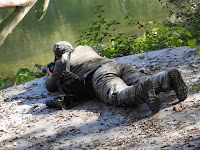Being at Sattal, the Birders' Paradise, Courtesy #StraboPixelClub
Twenty Seven Birding enthusiasts from across the countryPangot and were able to identify more than 130 different birds. The most sought after were the Brown Fish Owl, the Colloared Owlet, the Flower Peckers, the Leafbirds, the Common Green Magpies, the Crested Kingfishers, the Nut Hatchers, the Laughing Thrushes, the Woodpeckers and Himalayan Bulbuls. The rare finds included Eurasian Wren or the Nepal Wren Babbler and the Brown Dipper.
 |
| The commitment of Arvind Syal |
 |
| With Hemant Bishnoi and Subroto Chatterjee |
The highlight of the event was an exhibition of photographs of birds held at the iheart Cafe which was inaugurated by the Divisional Forest Officer, Mr D.S.Meena,IFS. In his address, Mr Meena highlighted various steps being taken by the Uttrakhand Government to preserve and improve the rich biodiversity of the state. He said that the steps being taken by the Forest Department need to be supplemented by people at the grassroot level.
 |
| Collared Owlet |
 |
| Brown Fish Owl |
Strabo Pixel Club he brainchild of Hemant Bishnoi and his wife Anu , supported by Puneet Virmani and Subroto Chatterjee. The club has been named after Strabo who was one of the earlier Geographer who is credited with drawing probably the first world map. Strabo Pixel Club has a vast membership base of 1.56 Lakhs at this moment and is getting enlarged with each day. It is a unique platform that networks birders not only across the country but also globally.
The event was sponsored by Discover India magazine, DTDC and iheart Cafe with active support of the Uttrakhand Forest Department. All the participants were given Participation Certificates, Mementoes , Camouflage jackets and a Coffee mug with a photograph clicked by the birder himself/herself. The entire arrangements for stay, boarding, local transport and hospitality was made by the Strabo Pixel Club personally supervised by Hemant Bishnoi and Anu Bishnoi.
The event was given wide media coverage by India News in its prime time news as well as in a dedicated feature.
